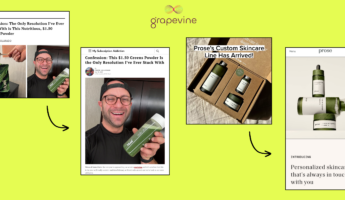Why All DTC Brands Should Be Running Whitelisting Campaigns on Meta
Whitelisting 101 – The Benefits and Performance Improvements
Whitelisting ads on platforms like Facebook and Instagram is the process where an influencer, creator or publisher gives you access to their pages and you run ads through them. The ads will appear as if they are coming from the influencer, creator or publisher’s Facebook and Instagram page.
There are endless benefits to running whitelisted campaigns on paid social, but the main two are the added social proof you are bringing into your marketing efforts as well as the authenticity and personal touch that comes through in whitelisted ads.
In general, whitelisted ads get higher CTRs and lower CPCs because they appear closer to native content rather than ads on these platforms. Users are more likely to engage with content that appears native to the platform and skip over content that is clearly there for advertising purposes.
Top DTC brands like Fabletics, Prose, Farmer’s Dog and more are all aggressively scaling their whitelisting campaigns through GrapevineAI’s platform with great success – not only are DTC brands using relevant, high-performing creators to whitelisting, but they are also directing traffic to a 3rd-party piece of editorial content.
Creator Whitelisting vs. Publisher Whitelisting
There are 2 different strategies for whitelisting ads on paid social. The first is whitelisting through top-tier creators and influencers and the second is whitelisting ads through reputable publishers.
Utilizing creators is the most common way to whitelist in 2023 – as the world and digital media landscape shifts more towards creator-driven content and creator-first media, users not only prefer to consume content from these creators, but they also prefer to hear about new products that the creator themselves recommends. That’s exactly why whitelisting ads through creators can perform incredibly well compared to branded ads.
When brands can utilize creators that closely align with their customer demographic and can authentically speak to an experience with the brand and their offering, the ads become even more authentic and personalized. The more authenticity, the better the performance can be.
Whitelisting through reputable publisher handles is a less-used tactic in DTC marketing but still an effective way to profitably acquire new customers.
Instead of running ads that are hyper-focused on conversion, publisher whitelisting encourages brands to run ads that educate consumers, tell an entertaining story, and share unique value props behind their products in an entertainment-first way.
Why DTC Brands Need To Be Capitalizing on Whitelisting in 2023
Whitelisting on paid social can drive significant CPA efficiencies for DTC brands – regardless of category or product offering. Across 150+ DTC brands that GrapevineAI partners with for whitelisting, the average CPA reduction is 20%+ when compared to branded campaigns.
Whitelisting is one of the most effective media strategies of 2023 and brands that aren’t tapping into it are leaving lots of money on the table in their Meta ad accounts – to the tune of 20-30% CPA efficiencies.
Brand partners of GrapevineAI, like Fabletics, Keeps and Honeylove, are winning on paid social with whitelisting – here are a few ways they are unlocking scale and performance:
- Utilizing creators, regardless of following size, that can authentic speak about an experience or opinion about the brand’s product and relay it in either video form or editorial form.
- Using editorial content from the creator themself as the landing page on paid social – not only are the brands whitelisting ads from the creator’s Facebook and Instagram page, but they are also running their traffic to third-party articles and editorial landing pages that the creator writes themselves.
- Launching multiple content angles and creator demographics at the same time to horizontally scale their audience and customer acquisition for the campaign. Diverse creator selection and content angles drives new targeting on Facebook and Instagram and allows the brand to tap into audiences they otherwise wouldn’t with their branded ads.
Connect with GrapevineAI To Seamlessly Launch Whitelisting Campaigns
If you’re looking to unlock new efficiencies in your acquisition efforts across digital channels like Meta and are interested in testing a third-party campaign, then GrapevineAI is here to support your growth team.
Grapevine, the only 3rd-party performance content platform built to serve DTC growth teams, is able to get your campaign up and running in just days, not weeks.
Not only does GrapevineAI’s platform enable growth marketers to tap into one of the most underutilized strategies on Meta, but it also eliminates all of the friction from the brand’s growth team associated with manually creating a whitelisting campaign from scratch.
Related posts

Discover what you should look for in a whitelisting partner in 2024 Third-party paid social whitelisting campaigns are known as one of the most effective strategies for DTC brands to drive more volume and lower CACs at scale. When executed properly with the right partner, these campaigns can outperform branded ad campaigns by as much […]

Learn how Grapevine AI is transforming paid social whitelisting campaigns for DTC brands. Third-party paid social campaigns can drive 20-30% CAC efficiencies for DTC brands when executed well and Grapevine is the top partner in the space doing this at scale for direct-to-consumer brands. These campaigns work because you’re leading with authentic creator content, driving […]
Feeling Frustrated With Your FB Performance? Creator Whitelisting Might Be Your Unlock. Creator whitelisting is one of the most effective paid social strategies to decrease your CPAs, introduce more creative diversity into your campaigns, and scale your media spend. Top spending DTC brands across the board have leaned into creator whitelisting throughout 2023 and are […]